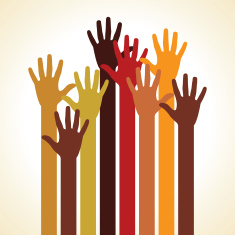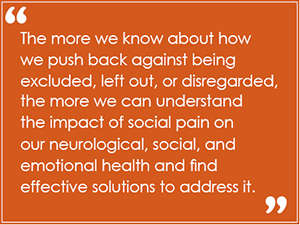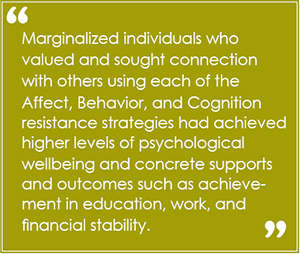 Everyone Needs to STOP the Pain!
Everyone Needs to STOP the Pain!
Everyone Needs the Pain to STOP!
Stopping the Pain of Social Exclusion
“Hands up!” The universal symbol of surrender, sign of protest, and signal for self-selection to take action. All of these are integral in stopping the pain of social exclusion.
Human beings are built to function physically, emotionally, and spiritually in supportive groups. This simple fact has recently been supported by neuroscience research and helps explain why individuals and groups of people that are marginalized or socially excluded often suffer from higher levels of chronic health problems and shorter life expectancy.
SPOT – Social Pain Overlap Theory1: How and Why Social Exclusion Hurts All of Us
Being part of a group is so critical to humans that our nervous system literally uses the same alarm (the dorsal anterior cingulate cortex) to register the danger and distress of physical pain or injury AND social exclusion. This neuroscience finding requires that we stop bifurcating pain into physical and emotional and start realizing that pain is pain and that social exclusion and marginalization are forms of violence that impact individuals and whole groups of people.
Social Pain forms – Covert and Overt
Social pain occurs in a number of different forms, some obvious, some not so obvious. The not so obvious may be hard to see, they are insidious like the background noise or the air we breathe. They are chronic assumptions about who we are and what our interests, strengths, and weaknesses might be. They are assumed by others and attached to our identities such as race, ethnicity, sexual orientation, and gender.
These subtle daily attacks or microaggressions can have devastating short- and long-term impact. For example, Native or Indigenous Americans constantly having to combat broad assumptions about cultural sacred practices, misuse of regalia, offensive displays of imagery in athletic team mascots, or even the ongoing challenge to defend one’s very existence.
 The obvious forms of social pain are glaringly obvious, often flagrant and extreme. Black men and women being stopped by police, detained or harassed, and imprisoned at sweepingly disproportionate rates compared to White people; too often resulting in violence and even murder.
The obvious forms of social pain are glaringly obvious, often flagrant and extreme. Black men and women being stopped by police, detained or harassed, and imprisoned at sweepingly disproportionate rates compared to White people; too often resulting in violence and even murder.
Bot the subtle and blatant forms of social pain emerge together and take place across a range of areas including reliable public safety, access to and quality of healthcare, education and jobs, affordable sustainable housing, and more. Both institutional and personal marginalization is the bedrock for social pain to occur in all of its many forms.
Psychological Resistance to Marginalization
What we know is that people who have been and are being marginalized have always pushed back in... READ MORE>> some way. Emerging ideas and theories about how and why to resist are being explored and developed. Psychological Resistance Theory2 is the central construct and reference point based on research about women of color who must confront marginalization and the ensuing social pain associated with both race and gender.
Research outlines optimal and suboptimal ways of resisting marginalization, and in fact both co-occur. Further exploration revealed that both optimal and suboptimal resistance strategies are used together and in patterned ways that have implications for how we manage marginalization and social pain. These strategies involve affect, behavior, and cognition (the ABC Framework of Resistance) in specific optimal and suboptimal paired forms known as Profiles of Resistance.3 For example, a “Purposeful Resister” may use optimal cognitive coping in their clear awareness of the marginalizing stressors, yet may also engage in suboptimal affect, which can give way to feelings of hopelessness and despair about long-term change over time. It is as if they cannot get up to go on another day under the weight of awareness about exclusionary worldviews and practices around them.
The more we know about how we push back against being excluded, left out, or disregarded, the more we can understand the impact of social pain on our neurological, social, and emotional health and find effective solutions to address it.
Social Pain is Everywhere
Social pain occurs in layers depending on who and where you are. It can be experienced in your family, at work, in your community, and often in more than one place. It is always embedded in our daily lives.
It is time to STOP the pain of social exclusion and here is one model we have created to help people take action to stop the pain of social exclusion wherever they may experience it, feel it, or participate in it. Because whether the initiator, the targeted, or the bystander, we are all capable of doing it and all are vulnerable to the effects of it.
STOP SPOT!
Each activity should be a multisensory experience incorporating your mind, your body, and your soul. When you STOP the pain of social exclusion and marginalization you are literally changing your own neurophysiology, as well as the neurophysiology of those around you. These activities can be used in daily human interactions wherever we see social exclusion arising.
To STOP SPOT you can try the following:
S – See Stratification
Use your eyes, mind, and body to discern what’s happening to you and around you. Being aware is the first step to combatting any damaging circumstance or issue. Social pain is embedded across the many layers of our lives and it is often so densely intertwined with everyday life that we often do not see it or we ignore it. The “it” could be the casual bigoted comment or a gender stereotype reflected in media. It can also be race- or ethnicity-based assumptions made about someone’s capability in the workplace or classroom. We must begin by seeing the stratification that we are perpetrating, experiencing, or witnessing.
NSFF (Neuroscience Fun Fact)
Seeing stratifications and value judgments toward you or others helps you to locate the problem outside of yourself, which in turn helps to lessen the shame and pain that accompanies the exclusion. Shame stimulates the parasympathetic nervous system often leading to a decrease in energy, motivation, and a withdrawal from human contact. In addition, the distress pain of social exclusion or marginalization may stimulate the sympathetic nervous system’s fight or flight response leading to chronic stress, which ultimately impairs the immune system. When this occurs often enough, the third pathway of the autonomic nervous system (the smart vagus) is not getting a regular workout from healthy relationships, making it more difficult to find calming comfort from close connections.4
 T – Talk and Tell
T – Talk and Tell
Use your voice, mind, and body to describe, express, and share what you see and feel. It is often said that there is power in the “spoken word” and when we talk through what we experience and witness it can lead to transformation and healing. Storytelling is a powerful change agent and we know that personal narrative is a central way humans make meaning of life. Therefore talking and telling are essential components of claiming power, especially in the midst of social pain. Telling one’s story can create a path of understanding and an avenue for others to understand and join you.
NSFF
When you talk and tell others about the experience of the social exclusion, you are using the muscles of facial expression as well as the muscles in your throat and larynx. As you communicate the experience you may listen more intently to the person you are sharing with. All of these actions stimulate the smart vagus nerve, which in turn will inhibit your sympathetic nervous system lowering the distress of being marginalized, witnessing or causing marginalization.
O – Open Outreach
Use your heart, mind, and body to deconstruct the hurtful impact of what is occurring and replace it with healing interactions. This may be the most challenging step in the process of stopping social pain. However, being open and vulnerable in acknowledging how you have either been hurt by, caused, or witnessed social pain is key to transformation. Being open and reaching out allows us to get in touch with our humanity and commonality, which is where all great change begins. It is core to human connection.
NSFF
It is biologically difficult to remain open and vulnerable when you are feeling threatened by social exclusion. Truth is, your sympathetic nervous system is usually running the show at this point and the message it is sending is to either flee from the situation or gear up to attack back. When you have participated or witnessed social exclusion, your sympathetic nervous system is also in charge. Regardless of where you are in the scenario your frontal lobe can be a huge help. With a little or a lot of help from this thinking part of your brain energy can be channeled towards an outreach to others who have your back and want to comfort and support you. This connection in a place of vulnerability and pain can be transformative. It reconnects you with a larger experience of wholeness or oneness within community and this bigger belonging helps to sooth the pain pathways that are activated by social exclusion. And healthy connection with others helps you to act in relationship to use your hurt, anger, or guilt for social change.
P – Partnered Protest…and Production
Use your networks, mind, and body to develop action that counters the social exclusion and pain that is happening, and create a new reality. Building alliances within group, across group, peer to peer, with many voices using multiple actions, we can forge connection and leverage our power to effect change exponentially.
NSFF
Partnered Protest amplifies the message of change and transformation. How does this happen? As a group moves into the physiology of healthy relationship, the level of pain they are experiencing or causing from being isolated, marginalized, or disconnected through powering over others lessens. Biological resonance through the mirror neuron system transforms individual voices into echoed support. Dopamine will flow freely as people interact in safety with one another and in a common purpose of social change. Dopamine provides focus, attention, and energy to act within the hurtful settings to change them. The smart vagus nerve will be engaged in these interactions adding a steady “de-stressing” message to the rest of the autonomic nervous system. Ultimately, lasting strength and staying power for social change comes from being centered, and held within healthy relationship!
The steps of the STOP model are timely, and can be further discussed in light of our current national climate, specifically around race and where we have also seen issues of gender and class come into play in intersecting and significant ways. The stories that are filling the daily headlines and news media cover the chronic to spiking attacks on people of color which are rooted in social exclusionary beliefs and practices interwoven into societal consciousness and functioning. Whether it is the ongoing critique, yet appropriation of, Black female form and style in pop culture or sports, or in the deluge of flagrant violence against unarmed Black men, women, and children at traffic stops, as praying congregants, among young teens at a pool party or upon a book club during a train ride, these cases reveal a much larger and longer set of socio-political realities reflecting the marginalization of Black people over centuries. The impact is a pernicious and painful attack on our collective being and psyche as a result of these direct and indirect messages that exclude and ultimately convey, “you don’t matter.” The social-justice resistance movements that are underway to counter this onslaught is exemplary of Seeing stratification in daily practices, Talking about racial injustice, Opening up to embrace one another in vulnerability and strength, and Partnering to protest and produce a new reality that confronts and combats the structural and interpersonal racism and inequality at the center of this social exclusion. Together we can and must STOP the assault on the physical, psychological and neurophysiological wellbeing of Black people. #BlackLivesMatter #BlackBrainsMatter.5 (-Karen T. Craddock)
ABC’s of Optimal Resistance to STOP SPOT
The STOP model fits well into the Affect, Behavior, and Cognitive (ABC) Framework of Resistance. Research shows that internal and external success or wellness is seen in resisters who incorporate connection and relationship-building into their strategies to counter social exclusion and marginalization.
Marginalized individuals who valued and sought connection with others using each of the Affect, Behavior, and Cognition resistance strategies had achieved higher levels of psychological wellbeing and concrete supports and outcomes such as achievement in education, work, and financial stability.5
Ultimately it comes down to our Partnered Protest…and Production. When we are able to come together to collectively resist exclusion, we can come to together to create new realities in an integrated fashion. It is at this step that we can begin to truly generate transformative change and overall wellness.
STOP as a Model of Optimal Resistance
SEE – using COGNITIVE capacities to discern
TALK – using BEHAVIORAL functions to express
OPEN – using AFFECTIVE means to engage
PARTNER – using AFFECTIVE, BEHAVORIAL and COGNITIVE strategies to build RELATIONAL connections
NSFF
Relational and individual neural integration and collective social action lead to optimal health and wellness for all. Integration should not be confused with assimilation or colorblindness. An essential component of STOP is to (SEE) your role in the circumstance and to take action with an awareness of the part you may play by omission or commission. Those holding race/gender/socioeconomic status privilege need to accept how they benefit from systemic social exclusion and enact STOP activities in their spheres of influence. This can begin by acknowledging how they may be immune to or blindly conspire with social exclusive activities. It is also necessary for those who are being marginalized to SEE the specifics of their marginalization while being careful not to subsume or minimize the marginalized pain of others. While resisting marginalization broadly, we must also resist the impulse to equate all social exclusionary realities and thereby reify systems of oppression within marginalized groups.
The upshot is that this notion of integration emphasizes honoring the distinct realities and experiences of marginalization that are socially constructed and operated in varying forms of hierarchy and intensity, and then come together as a strong force to counter the layers of social exclusion.
Taking Action to STOP SPOT
Because social pain in all of its forms occurs across multiple strata of our society, it is imperative that we take action to STOP SPOT at all levels which includes changing perspectives, practices and policy. This change must be done in interpersonal and systemic ways by integrating resistance strategies and healthy neuronal activity within us, in our relationships and across our institutions.
So, get those “hands up” to STOP SPOT!
Karen Craddock, Ph.D. is an Applied Psychologist and Principal Research Scientist whose study and practice for over 20 years concentrates on the socio-cultural context of human development, organizational capacity building, relational frameworks, community-based training and program evaluation research, particularly within the fields of Health and Education.
Amy Banks, M.D. has devoted her career to understanding the neurobiology of relationships. She is the first person to bring relational-cultural theory together with neuroscience and is the creator of the C.A.R.E. Program which helps clinicians and laypeople assess the quality of their relationships and strengthen their neural pathways for connection.
References: 1. Eisenberger and Lieberman, 2004; 2. Robinson and Ward , 1991; 3. Craddock, 2015; 2007; 4. Banks, 2015; 5. Craddock 2015, 2007

